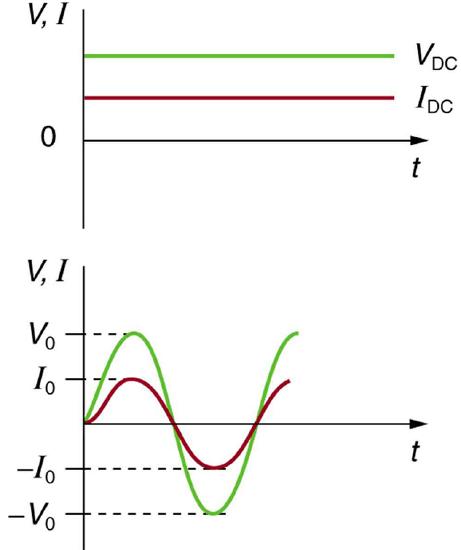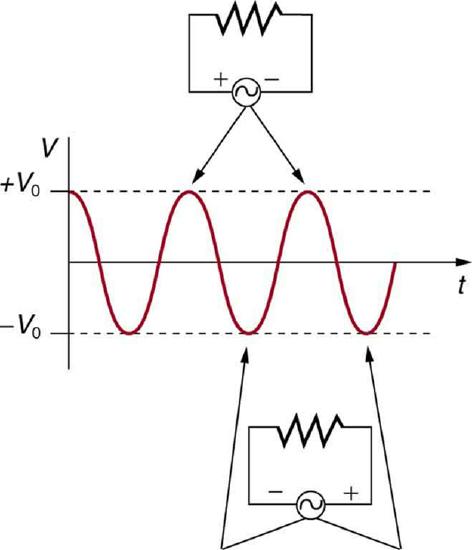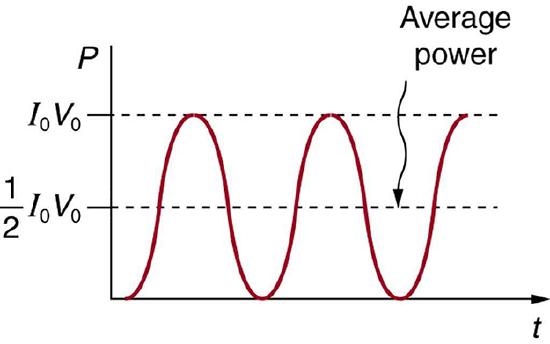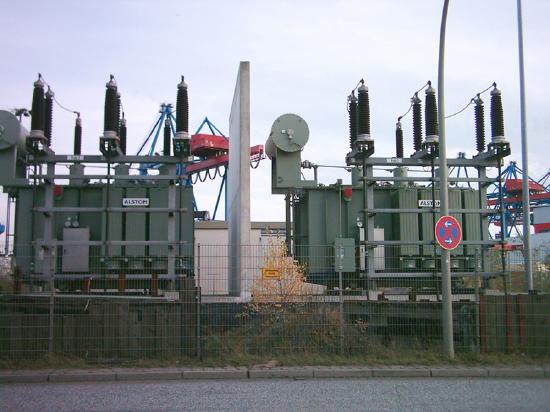10.12: Alternating Current versus Direct Current
- Page ID
- 46952
Learning Objectives
- Explain the differences and similarities between AC and DC current.
- Describe rms voltage, current, and average power.
- Explain why AC current is used for power transmission.
Alternating Current
Most of the examples in electric circuits, and particularly those utilizing batteries, have constant voltage sources. Once the current is established, it is thus also a constant. Direct current (DC) is the flow of electric charge in only one direction. It is the steady state of a constant-voltage circuit. Many well-known applications, however, use a time-varying voltage source. Alternating current (AC) is the flow of electric charge that periodically reverses direction. If the source varies periodically, particularly sinusoidally, the circuit is known as an alternating current circuit. Examples include the commercial and residential power that serves so many of our needs. Figure \(\PageIndex{1}\) shows graphs of voltage and current versus time for typical DC and AC power. The AC voltages and frequencies commonly used in homes and businesses vary around the world. The AC voltages range from 100 V to 240 V; the frequencies range from 50 Hz to 60 Hz.


Figure \(\PageIndex{2}\) shows a schematic of a simple circuit with an AC voltage source. The voltage between the terminals fluctuates as shown. For this example, the voltage and current are said to be in phase, as seen in Figure \(\PageIndex{1}\)(b).
Current in the resistor alternates back and forth just like the driving voltage, since \(I=V / R\). If the resistor is a fluorescent light bulb, for example, it brightens and dims 120 times per second as the current repeatedly goes through zero. A 120-Hz flicker is too rapid for your eyes to detect, but if you wave your hand back and forth between your face and a fluorescent light, you will see a stroboscopic effect evidencing AC. The fact that the light output fluctuates means that the power is fluctuating. The power supplied is \(P=I V\).
MAKING CONNECTIONS: TAKE-HOME EXPERIMENT—AC/DC LIGHTS
Wave your hand back and forth between your face and a fluorescent light bulb. Do you observe the same thing with the headlights on your car? Explain what you observe. Warning: Do not look directly at very bright light.

We are most often concerned with average power rather than its fluctuations—that 60-W light bulb in your desk lamp has an average power consumption of 60 W, for example. As illustrated in Figure \(\PageIndex{3}\). One common way to express an average is "root-mean-square," or "rms." For example, rms voltage of an AC voltage source is found by first squaring the voltage ("square"), taking an average of this value over one period of oscillation ("mean"), and taking the square root ("root").
It is standard practice to quote \(I_{\text {rms }}\), \(V_{\text {rms }}\), and \(P_{\text {ave }}\) rather than the peak values. For example, most household electricity is 120 V AC, which means that \(V_{\text {rms }}\) is 120 V. The common 10-A circuit breaker will interrupt a sustained \(I_{\text {rms }}\) greater than 10 A. Your 1.0-kW microwave oven consumes \(P_{\text {ave }}=1.0 \mathrm{~kW}\), and so on. You can think of these rms and average values as the equivalent DC values for a simple resistive circuit.
To summarize, when dealing with AC, Ohm’s law and the equations for power are completely analogous to those for DC, but rms and average values are used for AC. Thus, for AC, Ohm’s law is written
\[I_{\mathrm{rms}}=\frac{V_{\mathrm{rms}}}{R} . \nonumber \]
The various expressions for AC power \(P_{\text {ave }}\) are
\[P_{\text {ave }}=I_{\text {rms }} V_{\text {rms }}, \nonumber \]
\[P_{\mathrm{ave}}=\frac{V_{\mathrm{rms}}^{2}}{R}, \nonumber \]
and
\[P_{\mathrm{ave}}=I_{\mathrm{rms}}^{2} R. \nonumber \]
Why Use AC for Power Distribution?
Most large power-distribution systems are AC. Moreover, the power is transmitted at much higher voltages than the 120-V AC (240 V in most parts of the world) we use in homes and on the job. Economies of scale make it cheaper to build a few very large electric power-generation plants than to build numerous small ones. This necessitates sending power long distances, and it is obviously important that energy losses en route be minimized. High voltages can be transmitted with much smaller power losses than low voltages, as we shall show below. (See Figure \(\PageIndex{4}\).) For safety reasons, the voltage at the user is reduced to familiar values. The crucial factor is that AC voltages can be increased and decreased efficiently with transformers (which uses electromagnetic induction to produce time-varying voltages), while it is more difficult to change DC voltages without power losses. So AC is used in most large power distribution systems.

Example \(\PageIndex{1}\): Power Losses Are Less for High-Voltage Transmission
(a) What current is needed to transmit 100 MW of power at 200 kV? (b) What is the power dissipated by the transmission lines if they have a resistance of \(1.00 ~\Omega\)? (c) What percentage of the power is lost in the transmission lines?
Strategy
We are given \(P_{\text {ave }}=100 ~\mathrm{MW}\), \(V_{\mathrm{rms}}=200 ~\mathrm{kV}\), and the resistance of the lines is \(R=1.00 ~\Omega\). Using these givens, we can find the current flowing (from \(P=I V\)) and then the power dissipated in the lines (\(P=I^{2} R\)), and we take the ratio to the total power transmitted.
Solution
To find the current, we rearrange the relationship \(P_{\text {ave }}=I_{\text {rms }} V_{\text {rms }}\) and substitute known values. This gives
\[I_{\mathrm{rms}}=\frac{P_{\text {ave }}}{V_{\text {rms }}}=\frac{100 \times 10^{6} \mathrm{~W}}{200 \times 10^{3} \mathrm{~V}}=500 \mathrm{~A}. \nonumber\]
Solution
Knowing the current and given the resistance of the lines, the power dissipated in them is found from \(P_{\text {ave }}=I_{\text {rms }}^{2} R\). Substituting the known values gives
\[P_{\text {ave }}=I_{\text {rms }}^{2} R=(500 \mathrm{~A})^{2}(1.00 \Omega)=250 \mathrm{~kW}. \nonumber\]
Solution
The percent loss is the ratio of this lost power to the total or input power, multiplied by 100:
\[\% \text { loss }=\frac{250 \mathrm{~kW}}{100 ~\mathrm{MW}} \times 100=0.250 ~\%. \nonumber\]
Discussion
One-fourth of a percent is an acceptable loss. Note that if 100 MW of power had been transmitted at 25 kV, then a current of 4000 A would have been needed. This would result in a power loss in the lines of 16.0 MW, or 16.0% rather than 0.250%. The lower the voltage, the more current is needed, and the greater the power loss in the fixed-resistance transmission lines. Of course, lower-resistance lines can be built, but this requires larger and more expensive wires. If superconducting lines could be economically produced, there would be no loss in the transmission lines at all. But, as we shall see in a later chapter, there is a limit to current in superconductors, too. In short, high voltages are more economical for transmitting power, and AC voltage is much easier to raise and lower, so that AC is used in most large-scale power distribution systems.
Section Summary
- Ohm’s law for AC is \(I_{\mathrm{rms}}=\frac{V_{\mathrm{rms}}}{R}\).
- Expressions for the average power of an AC circuit are \(P_{\text {ave }}=I_{\text {rms }} V_{\text {rms }}\), \(P_{\text {ave }}=\frac{V_{\text {rms }}{ }^{2}}{R}\), and \(P_{\mathrm{ave}}=I_{\mathrm{rms}}^{2} R\), analogous to the expressions for DC circuits.
Glossary
- direct current
- (DC) the flow of electric charge in only one direction
- alternating current
- (AC) the flow of electric charge that periodically reverses direction
- AC voltage
- voltage that fluctuates sinusoidally with time.
- AC current
- current that fluctuates sinusoidally with time.
- rms
- a type of average taken for a time-varying quantity by squaring it, taking the mean of the square, and then taking the square-root of the mean.


